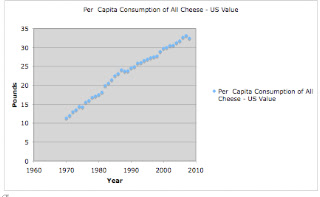Ever wonder what it means when a Manchego wrapper says “6 months aged” or maybe even 12 months? What does it mean for a cheese to be aged and how could this effect its overall quality and flavor? In the cheese world the aging process is known as “Affinage.” According to the “Cheese Connoseiur Glossary,” Affinage is “the craft of maturing and aging cheeses.” When a cheese ages that doesn’t just mean a wheel is set on a shelf for a few months and then plucked off when it is time to be sent to cheese counters around the country and the world. People known as “affineurs” are in charge of overseeing and testing the development of the cheeses. It is their responsibility to taste cheeses as they ripen and evolve throughout the aging process. They make sure that the cheeses are held in climate controlled rooms and might even tend to the cheese by soaking the outer rinds and changing the taste of the cheese. As much as the affineur can look over the cheeses, once a cheese goes bad…its bad—there is no going back.
According to the NY Times, “Affinage is the careful practice of ripening cheese, but it’s about much more than simply letting a few stinky wheels sit until some magical buzzer goes off. For those who believe the affinage gospel, it is about a series of tedious, ritualized procedures (washing, flipping, brushing, patting, spritzing) that are meant to inch each wheel and wedge toward an apex of delectability.”
However, many believe that the ways of affinage are just ways to inflate the prices of cheese and that all the washes and attention to small details dont really do anything. Many believe that it is just a market scheme and by saying that the product has aged longer, it is therefore more precious; just like an old painting might be of more value than a new one. However, some say that the affinage process determines the texture and flavor of the cheese and that the caves in which the cheese sits in are extrememly influential on the cheese.

Whether you are a supporter of affinage or not, the ageing process is something that is key in the cheese making world. According to goodfoodrev.com, “There are three key components to proper ageing – a proper facility, real understanding of the cheese making and ageing processes, and A LOT of discipline.”-
The term affinage is a French term that is adapted from the Latin “ad finis” which means “towards the limit.” The Affiner helps a cheese develop to the edge of its ageing ability. However according to cheesesociety.org, “Aging and maturing is not a precise science: the animal, the flora, the quality of the milk, the terroir, the season have an influence on the cheeses; the skill of the affineur is to be able to adapt his techniques and methods to the cheeses. This knowledge comes with time and experience.”

There are many important parts to affinage. From the locations that the cheeses are stored and aged in (cheese caves etc.-temperature controlled rooms) to the treatments done on the cheeses over time, affinage is a complicated procedure. Cheesesociety.org sums up many of key aspects to the affinage process which are listed below:
I. What is cheese affinage?
A. Relationship of affinage to cheese flavor and texture development
Lipolysis
Breakdown of fats
Enzymatic action
Proteolysis
Breakdown of proteins
Culture action
Desiccation
Treatments
Washing
Brushing/patting
Submersion in solution (brine, alcohol, etc.)
Turning
Humidity
Temperature
B. Historical roots of cheese affinage, European traditions, and American adaptations
C. Who are Affineurs (cheese agers)?
Producers
Affineurs (examples: Cellars at Jasper Hill, Neal’s Yard Dairy, Mons…)
Defining a cheese selection
Relationship with producers
Retailers (examples: Murray’s, Formaggio Kitchen…)
Every type of cheese has different factors that are necessary to watch and attend to during the aging process but these factors are the most generic things that affect cheese affinage…
II. General factors affecting cheese affinage
A. Time
B. Temperature
C. Humidity
D. Molds
E. Micro conditions in aging rooms
F. Cheese microflora (raw milk, heat treated, pasteurized, cultures, adjuncts)
G. Cheese manufacturing methods
H. Packaging materials (or lack thereof)
I. Shelving materials and conditions
III. Affinage Systems
A. Natural caves
B. Manmade caves (earthen mounds)
C. Fabricated affinage systems
D. Cheese coolers
IX. Maintaining food safety during cheese affinage
A. Pathogens of concern
B. Spoilage organisms of concern
C. GMPs (Good Manufacturing Practices) and HAACP (Hazard Analysis and Critical Control Points)
D. Sanitation requirements
X. Maintaining cheese quality from packaging through distribution to retail sale
A. Cutting, wrapping and packaging issues
B. Selection of the correct packaging materials by cheese variety
C. Sensitivity of different cheese varieties to abuse during distribution and retail sales
D. Shelf life concerns with different cheese varieties
E. Labeling issues-varies by country
F. Marketing strategies
Affinage is not a simple process in any form. It takes patience, practice, and the ability to recognize what a specific cheese needs.





